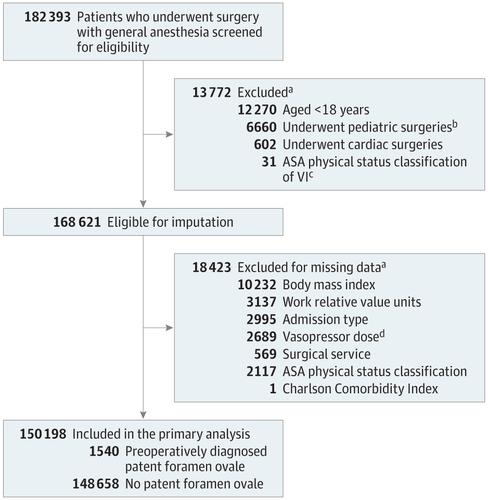Our official English website, www.x-mol.net, welcomes your
feedback! (Note: you will need to create a separate account there.)
Association of Preoperatively Diagnosed Patent Foramen Ovale With Perioperative Ischemic Stroke
JAMA ( IF 63.1 ) Pub Date : 2018-02-06 , DOI: 10.1001/jama.2017.21899 Pauline Y. Ng 1, 2 , Andrew K.-Y. Ng 3, 4 , Balachundhar Subramaniam 5 , Sara M. Burns 1 , Fanny Herisson 6 , Fanny P. Timm , Cand Med 1 , Maira I. Rudolph , Cand Med 1 , Flora Scheffenbichler , Cand Med 1 , Sabine Friedrich , Cand Med 1 , Timothy T. Houle 1 , Deepak L. Bhatt 3 , Matthias Eikermann 1, 5
JAMA ( IF 63.1 ) Pub Date : 2018-02-06 , DOI: 10.1001/jama.2017.21899 Pauline Y. Ng 1, 2 , Andrew K.-Y. Ng 3, 4 , Balachundhar Subramaniam 5 , Sara M. Burns 1 , Fanny Herisson 6 , Fanny P. Timm , Cand Med 1 , Maira I. Rudolph , Cand Med 1 , Flora Scheffenbichler , Cand Med 1 , Sabine Friedrich , Cand Med 1 , Timothy T. Houle 1 , Deepak L. Bhatt 3 , Matthias Eikermann 1, 5
Affiliation

|
Importance Perioperative stroke is a major complication for patients undergoing surgery. Patent foramen ovale (PFO) represents a possible anatomical link between venous thrombosis and stroke. Objective To determine whether a preoperatively diagnosed PFO is associated with increased risk of perioperative ischemic stroke. Design, Setting, and Participants Retrospective cohort study from Massachusetts General Hospital and 2 affiliated community hospitals between January 1, 2007, and December 31, 2015. Participants were 182 393 consecutive adults undergoing noncardiac surgery with general anesthesia. Exposures Preoperatively diagnosed PFO. Main Outcomes and Measures Perioperative ischemic stroke occurring within 30 days of surgery; stroke subtype by Oxfordshire Community Stroke Project classification and stroke severity by National Institute of Health Stroke Scale (NIHSS). Results Among the 150 198 patient cases analyzed (median [SD] age, 55 [16] years), 1540 (1.0%) had a diagnosis of PFO before surgery. A total of 850 (0.6%) ischemic strokes occurred within 30 days of surgery (49 [3.2%] among patients with PFO and 801 [0.5%] among patients without PFO). In adjusted analyses, patients with PFO had an increased risk of ischemic stroke compared with patients without PFO (odds ratio, 2.66 [95% CI, 1.96-3.63]; P < .001). The estimated risks of stroke were 5.9 for every 1000 patients with PFO and 2.2 for every 1000 patients without PFO (adjusted absolute risk difference, 0.4% [95% CI, 0.2%-0.6%). Patients with PFO also had an increased risk of large vessel territory stroke (relative risk ratio, 3.14 [95% CI, 2.21-4.48]; P < .001) and a more severe stroke-related neurologic deficit measured by NIHSS (median, 4 [interquartile range {IQR}, 2-10] vs median, 3 [IQR, 1-6] for those without PFO; P = .02). Conclusions and Relevance Among adult patients undergoing noncardiac surgery at 3 hospitals, having a preoperatively diagnosed PFO was significantly associated with increased risk of perioperative ischemic stroke within 30 days after surgery. Further research is needed to confirm these findings and to determine whether interventions would decrease this risk.
中文翻译:

术前诊断的卵圆孔未闭与围手术期缺血性卒中的关联
重要性 围手术期卒中是接受手术的患者的主要并发症。卵圆孔未闭 (PFO) 代表静脉血栓形成和中风之间可能存在的解剖学联系。目的 确定术前诊断出的 PFO 是否与围手术期缺血性卒中风险增加有关。设计、设置和参与者 2007 年 1 月 1 日至 2015 年 12 月 31 日期间,来自马萨诸塞州总医院和 2 家附属社区医院的回顾性队列研究。参与者为 182393 名连续接受全身麻醉非心脏手术的成人。暴露 术前诊断的 PFO。主要结果和措施 手术后 30 天内发生的围手术期缺血性卒中;牛津郡社区卒中项目分类的卒中亚型和美国国立卫生研究院卒中量表 (NIHSS) 的卒中严重程度。结果 在分析的 150 198 例患者病例中(中位 [SD] 年龄,55 [16] 岁),1540 例 (1.0%) 在手术前被诊断为 PFO。手术后 30 天内共有 850 例(0.6%)缺血性卒中发生(PFO 患者 49 例 [3.2%],无 PFO 患者 801 例 [0.5%])。在调整后的分析中,与没有 PFO 的患者相比,有 PFO 的患者发生缺血性卒中的风险增加(比值比,2.66 [95% CI,1.96-3.63];P < .001)。每 1000 名有 PFO 的患者中风的估计风险为 5.9,每 1000 名没有 PFO 的患者为 2.2(调整后的绝对风险差异,0.4% [95% CI,0.2%-0.6%)。PFO 患者的大血管区卒中风险也增加(相对风险比,3.14 [95% CI,2.21-4.48];P < .001),NIHSS 测量的卒中相关神经功能缺损更严重(中位数,4 [四分位距 {IQR},2-10] 与中位数,3 [IQR,1-6] 对于那些没有 PFO 的人;P = .02)。结论和相关性 在 3 家医院接受非心脏手术的成年患者中,术前诊断为 PFO 与术后 30 天内围手术期缺血性卒中风险增加显着相关。需要进一步的研究来证实这些发现并确定干预措施是否会降低这种风险。3 [IQR, 1-6] 对于没有 PFO 的人;P = .02)。结论和相关性 在 3 家医院接受非心脏手术的成年患者中,术前诊断为 PFO 与术后 30 天内围手术期缺血性卒中风险增加显着相关。需要进一步的研究来证实这些发现并确定干预措施是否会降低这种风险。3 [IQR, 1-6] 对于没有 PFO 的人;P = .02)。结论和相关性 在 3 家医院接受非心脏手术的成年患者中,术前诊断为 PFO 与术后 30 天内围手术期缺血性卒中风险增加显着相关。需要进一步的研究来证实这些发现并确定干预措施是否会降低这种风险。
更新日期:2018-02-06
中文翻译:

术前诊断的卵圆孔未闭与围手术期缺血性卒中的关联
重要性 围手术期卒中是接受手术的患者的主要并发症。卵圆孔未闭 (PFO) 代表静脉血栓形成和中风之间可能存在的解剖学联系。目的 确定术前诊断出的 PFO 是否与围手术期缺血性卒中风险增加有关。设计、设置和参与者 2007 年 1 月 1 日至 2015 年 12 月 31 日期间,来自马萨诸塞州总医院和 2 家附属社区医院的回顾性队列研究。参与者为 182393 名连续接受全身麻醉非心脏手术的成人。暴露 术前诊断的 PFO。主要结果和措施 手术后 30 天内发生的围手术期缺血性卒中;牛津郡社区卒中项目分类的卒中亚型和美国国立卫生研究院卒中量表 (NIHSS) 的卒中严重程度。结果 在分析的 150 198 例患者病例中(中位 [SD] 年龄,55 [16] 岁),1540 例 (1.0%) 在手术前被诊断为 PFO。手术后 30 天内共有 850 例(0.6%)缺血性卒中发生(PFO 患者 49 例 [3.2%],无 PFO 患者 801 例 [0.5%])。在调整后的分析中,与没有 PFO 的患者相比,有 PFO 的患者发生缺血性卒中的风险增加(比值比,2.66 [95% CI,1.96-3.63];P < .001)。每 1000 名有 PFO 的患者中风的估计风险为 5.9,每 1000 名没有 PFO 的患者为 2.2(调整后的绝对风险差异,0.4% [95% CI,0.2%-0.6%)。PFO 患者的大血管区卒中风险也增加(相对风险比,3.14 [95% CI,2.21-4.48];P < .001),NIHSS 测量的卒中相关神经功能缺损更严重(中位数,4 [四分位距 {IQR},2-10] 与中位数,3 [IQR,1-6] 对于那些没有 PFO 的人;P = .02)。结论和相关性 在 3 家医院接受非心脏手术的成年患者中,术前诊断为 PFO 与术后 30 天内围手术期缺血性卒中风险增加显着相关。需要进一步的研究来证实这些发现并确定干预措施是否会降低这种风险。3 [IQR, 1-6] 对于没有 PFO 的人;P = .02)。结论和相关性 在 3 家医院接受非心脏手术的成年患者中,术前诊断为 PFO 与术后 30 天内围手术期缺血性卒中风险增加显着相关。需要进一步的研究来证实这些发现并确定干预措施是否会降低这种风险。3 [IQR, 1-6] 对于没有 PFO 的人;P = .02)。结论和相关性 在 3 家医院接受非心脏手术的成年患者中,术前诊断为 PFO 与术后 30 天内围手术期缺血性卒中风险增加显着相关。需要进一步的研究来证实这些发现并确定干预措施是否会降低这种风险。











































 京公网安备 11010802027423号
京公网安备 11010802027423号